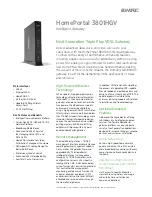
ZyWAN - User Manual
104
110150-1001F
Note:
When adding or deleting rows of a
Serial Ports Table
, make sure to click the
Insert
Row#
or
Delete Row#
buttons within the brown section of the
Serial Ports Table
, not
the buttons at the very bottom of the main table.
The following table lists the buttons available in the
Serial Ports Table
.
BUTTON
EXPLANATION
Insert Row#
Each row of the
Serial Ports Table
contains the definition of a
serial port to use for this Terminal Server configuration. One
Terminal Server may send data received from the network client
to multiple serial ports simultaneously. In order to insert a row in
the table, enter a number in the box between 1 and one greater
than the highest number of rows. Then click the
Insert Row#
button to insert a blank row. This row must be filled in with all
data required.
Delete Row#
In order to delete a row of the
Serial Ports Table
, enter a
number in the box between 1 and the highest number of rows.
Then click the
Delete Row#
button to delete the row. Once a
row is deleted, it cannot be restored without inserting a row and
entering the data again.
The following table lists the options available for the
Serial Ports Table
. At least one row of the
Serial Ports
Table
is required for the Terminal Server to operate.
FIELD/OPTION
EXPLANATION
COM Port
Select the serial COM port to which the Terminal Server data is sent.
Important:
Make sure this COM port is not configured for another
service in the ZyWAN. Otherwise, both services may
conflict for the port and not operate correctly.
It is possible in some applications to configure two
Terminal Servers to use the same COM port. In order for
this to work, the
Demark
option must be set to
Half Duplex
or
Broadcast
. In
Half Duplex
mode, the clients connecting
to each port may need to wait much longer for a response,
since the
Demark
and
Response Timeout
times for all
connections are observed, in the order that the requests
are received from each client.
Baud Rate
Select the baud rate to use for the Terminal Server port. Baud rate
options range from 1200 to 115,200 bps.
Data Bits
Select the number of data bits to use for the Terminal Server port.
Options are
5
,
6
,
7
, and
8
.
Parity
Select the parity to use for the Terminal Server port. Options are
None
,
Odd
,
Even
,
Mark
,
Space
.
Stop Bits
Select the number of stop bits to use for the Terminal Server port.
Options are
1
,
1.5
, and
2
.
Flow Control
Select whether to use hardware flow control for the Terminal Server
port. Options are
None
, and
RTS/CTS
(hardware flow control).
Summary of Contents for ZyWAN
Page 12: ...ZyWAN User Manual 12 110150 1001F This page intentionally blank ...
Page 13: ...PART 1 GETTING STARTED 13 110150 1001F PART 1 GETTING STARTED ...
Page 39: ...PART 2 SOFTWARE CONFIGURATION 39 110150 1001F PART 2 SOFTWARE CONFIGURATION ...
Page 113: ...PART 3 CONFIGURATION EXAMPLES 113 110150 1001F PART 3 CONFIGURATION EXAMPLES ...
Page 126: ...ZyWAN User Manual 126 110150 1001F Dimensions of ZyWAN Faceplate ...
















































